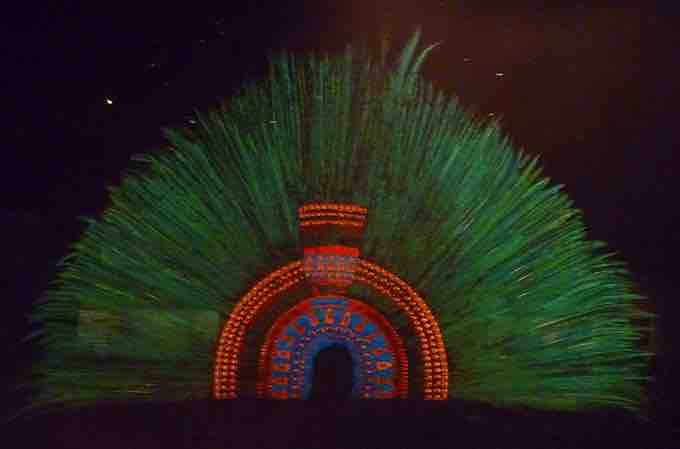Aztec Featherwork
Featherwork is the working of feathers into a cultural artifact, which was an especially elaborate art form among the Aztecs. Endowed with sacred meaning, feathers were associated with the Aztec patron deity Huitzilopochtli and the mythical god of featherworkers, Coyotlinahual. Feathers were incorporated into many aspects of life, including traditional clothing, armor for warfare, elaborate headdresses, and beautiful works of art. Artisans specializing in featherwork often worked full-time to produce fine luxury goods for noble patrons during the height of the Aztec empire.
Symbol of Status
Perhaps the most well-known example of Aztec featherwork is the feather headdress, such as the one thought to be worn by Moctezuma II. As the Aztec emperor at the time of the Spanish conquest, his headdress was made of quetzal and other feathers and mounted in a base of gold and precious stone.

Aztec feather headdress
This Aztec headdress is often described as the crown of Moctezuma II. Today it is exhibited at the Museo Nacional de Antropología e Historia, México.
Aztec warriors, or cuāuhocēlōtl, were distinguished in bravery and skill by their helmets and uniforms. In particular, the Eagle Aztec warriors wore feathered helmets to mark their ability. Ornamental shields, or māhuizzoh chimalli, were often decorated with motifs made in featherwork.
ClothingThe huipil is the most common traditional garment worn today by indigenous women from central Mexico to Central America. It is the only garment in Mexico which uses the pre-Hispanic art of featherwork, and the most complicated designs are generally known only to a few older master weavers. Designs are embedded into the fabric of the huipil, along with decorative elements such as embroidery, ribbon, feathers, lace, wax, and even gold thread. After the Aztec Empire was invaded and conquered by the Spanish, the huipil evolved to incorporate elements from Europe and even Asia.
Effects of Evangelization
In the early years of evangelization, the Aztec's use of feathers was adopted by Christians in the creation of religious objects, including feather paintings with Christian subjects. The sacredness of feathers, which for the Aztecs stemmed back long before the conquest, became associated with Christian forms of veneration. They were used to adorn triumphal arches, the bases of crosses, and the litters and canopies in which the host was carried during the Corpus Christi festival.